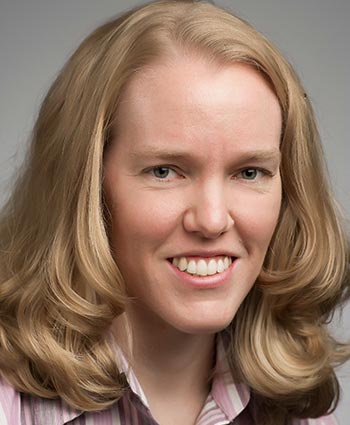Janna Martinek Works Behind the Scenes To Solve Some of NREL's Most Complex Problems

Since joining the National Renewable Energy Laboratory (NREL) in 2012, Janna Martinek has developed a reputation across the laboratory as a leader in numerical modeling and related engineering. She is also known as someone who can handle any problem that is thrown her way—no matter how complex.
"The thing about Janna is that she's really, really good at any type of modeling or design effort that you put in front of her," said Mark Mehos, who manages the Thermal Systems Research and Development Group. "She can take something she knows little about, become an expert in it in a short amount of time, and then provide a top-notch product."

Janna Martinek
Janna's expertise ranges from computational fluid dynamics modeling to grid modeling to optical and thermal modeling of solar receivers—a remarkable range.
"I'd go as far as to say that she has single-handedly increased the reputation of our work at NREL," Mehos said. "That's a bold statement, but she is involved in such a variety of projects that she bolsters NREL's reputation across the board."
Though Janna's expertise is wide-ranging, her primary research is focused on concentrating solar power (CSP)—a technology that uses mirrors to focus concentrated sunlight on a receiver, which in turn produces thermal energy that can be used to generate electricity or to generate heat to drive industrial processes.
"I often get pulled into many different areas," Martinek said. "But my focus is on producing CSP models that are as accurate as possible to understand how we can change the designs to get them to perform optimally."
That research plays an important role in decarbonization efforts, particularly in utility-scale applications, but it often flies under the radar.
"Outside of those who work in CSP, many people don't realize that the field exists. People hear 'solar' and they automatically think of photovoltaics, but CSP has so many interesting characteristics that are distinct from photovoltaics," Martinek said. "I think it's important that we get the technology out there more broadly."
Martinek first began working on CSP as a graduate student, but her interest in science and mathematics started when she was young.
"My family is very science- and math-minded, so I was exposed to it a lot growing up, and I always knew I'd do something in those fields," she said.
And although her career path looks linear on paper—she received both her B.S. and Ph.D. in chemical engineering from the University of Colorado, then joined NREL as a chemical engineer—Martinek was not initially sure about pursuing a career in research.
"I really didn't know whether I wanted to pursue a Ph.D. until the day before I submitted the application," she said. "I decided to apply because I had a professor who talked me into working in a lab one summer. The experience opened my eyes to what doing research meant and took a bit of the mystique out of it."
Martinek's colleagues at NREL and beyond are glad that she chose to pursue this path.
"The last presentation I heard Janna give—at a DOE workshop on Generation 3 CSP—was just amazing," Mehos said. "She explains things in a way that's very easy to understand for very complex material. And she did it in a way nobody else could have done."
Despite her extraordinary talents and contributions, Martinek's work has remained largely behind the scenes.
"Janna doesn't like the limelight," Mehos said. "But for every project that she's worked on, she has been instrumental in making it a success."
Last Updated May 28, 2025
